Feature story
A Fisherman and an International Student Board a Boat
At a lake in the Texas Hill Country, small-town fishermen build unlikely bonds with college students from overseas.
March 2018
The hardness of the dirt path caused pain to shoot through my boots. As I neared the end of my first 14-mile day of walking, I thought, Is this really what a pilgrimage is meant to be?
Why spend six days walking when I can experience Jesus without any of it?
I wondered what drew people to this ancient path. How could completing a 75-mile walk show me God? It was too late to turn back now.
Earlier that day, expectation filled me as I set off from Sarria, a town just over 70 miles from Santiago de Compostela, Spain. With 13 Cru® staff members and friends, I became a pilgrim along the Camino de Santiago.
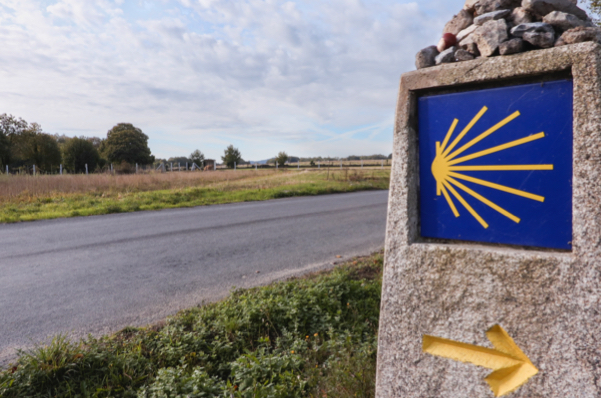
A stone kilometer marker guides pilgrims along the Camino. The markers, etched with yellow arrows and scallop shells, state the distance to Santiago de Compostela, the trail’s end.
I hoped that making the Camino pilgrimage would provide space to reflect on key moments of the past few years, including my own health challenges and my dad’s fight with a physically debilitating disease.
“God, what do you want to show me on this trip?” I prayed, while doubting God would speak during the walk.
With my magenta hiking boots laced tightly, I took a deep breath and started along the well-worn footpath. A yellow scallop shell symbol marked the way.
Every year, tens of thousands of people from around the world walk the Camino de Santiago (the Way of Saint James), a 500-mile pilgrimage through Northwest Spain. Some church traditions say the apostle James walked this route to take the gospel into Spain.
Today, pilgrims hike the trail for recreation, adventure, and spiritual or religious reasons. Many walk to contemplate their lives, shed heavy burdens, refresh their spiritual lives or find God.
As 21st-century Christians, many of us from cultures that no longer walk very much, we can easily overlook how God speaks in Scripture about the spiritual discipline of this physical activity.
God restored my soul by taking my feet to the breaking point.
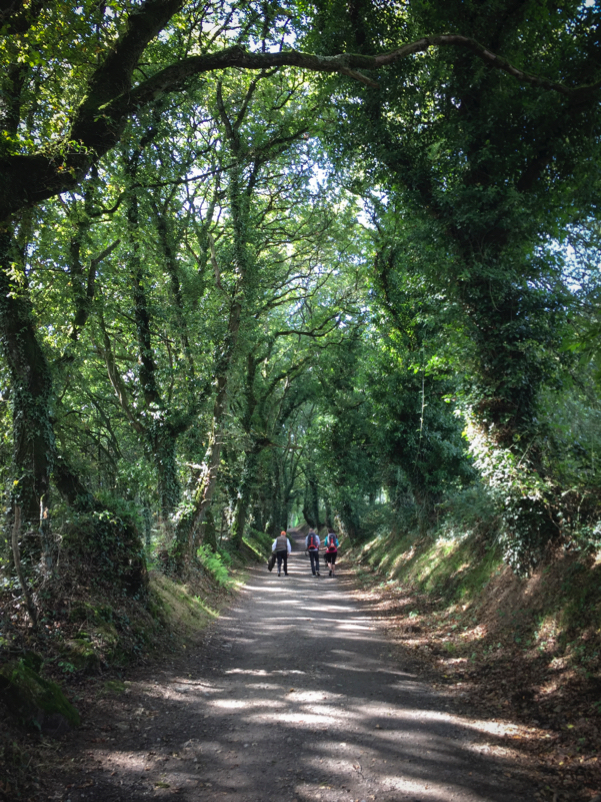
The path of the Camino leads pilgrims through a small forest. Today, pilgrims hike the ancient trail for recreation, adventure, and spiritual or religious reasons.
During a week of walking, I was reminded of truths that remain relevant to all believers.
On the second day of walking, my group stopped at an old stone guesthouse run by Agape (as Cru is known in Western Europe). Agape established the house in 1999 as a way to minister to pilgrims hiking the Camino. Workers at the house regularly witness pilgrims encountering the living God along the trail.
I listened as one of the workers told us a story.
One man walked the 500-mile trail 29 times—each time searching for something missing in his life. During his 30th journey, he stopped at this guesthouse with a distinctly slanted roof and a sign that read, La Fuente del Peregrino (The Fountain of the Pilgrim).
He stepped inside for a place to stay. Natán de Sousa, the director of the house, struck up a conversation. Natán pointed the pilgrim to a plaque outside, “Yo soy el camino, y la verdad, y la vida. — Jesús” (“I am the way, and the truth, and the life.” — Jesus).
At the guesthouse early the next morning, nearly 50 miles away from the final destination, the man decided to return home. Reading the guestbook, Natán understood why.
The man wrote that he no longer needed to search. He had found Jesus.
As a pilgrim hiking a portion of the same trail, I wondered if God might meet me here, too.
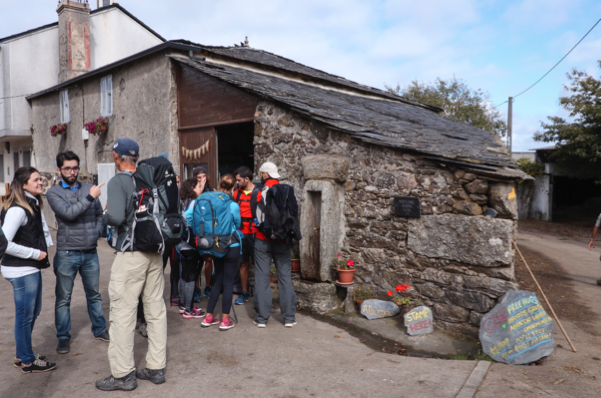
Volunteers at La Fuente del Peregrino (The Fountain of the Pilgrim) guesthouse greet pilgrims and offer free hot beverages, conversation and stamps for the Camino passports every pilgrim must carry. Agape (as Cru® is known in Western Europe) established La Fuente del Peregrino in 1999 as a way to minister to pilgrims.
At a crowded pilgrim café, I stood in a 20-person restroom line, waiting as an able-bodied helper lifted one man from his wheelchair and into the narrow bathroom.
Several times, my group and I passed a team of 15 individuals along the unpaved path. Some in the group had physical disabilities—using wheelchairs, crutches or metal walkers. Some were able-bodied helpers. Finishing the Camino would bring more uphill climbs and long days. But we never saw their smiles fade.
At the dinner table one night, a member of my group recounted her experience interacting with this team. She helped push a woman’s wheelchair up one of the Camino’s many rocky hills. My groupmate was recovering from knee surgery, and watching this team persevere inspired her.
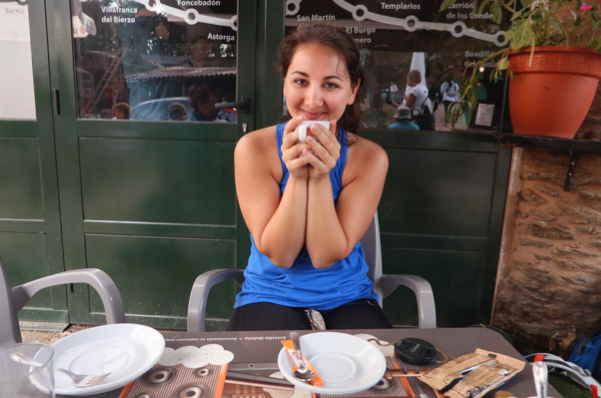
Rachel Geckle holds a café con leche, a strong coffee with hot milk. Cafés along the trail provide opportunities for pilgrims to rest, eat and drink, chat with other pilgrims, and use an indoor bathroom.
I set out on the Camino wanting this time to be about God and me. But the communal aspect of the trip challenged my thinking. Up until this point, most of my group members didn’t know that I also related to the team with physical disabilities.
Then tears fell as I let my companions into my world.
I saw my dad in these people—physically bound by a wheelchair but living with enduring joy. I saw my mom in the helpers—pushing the wheelchair, overcoming hurdles and providing care.
To these pilgrims, and to my parents, the journey is about finishing together.
How often do we miss a vital biblical principle of caring for others and allowing others to care for us?
“One more step,” I repeated to my friend as pain seared in my soles.
“One more step,” she responded.
The mental battle of this 17-mile day drained our energy. “I think this is changing my perspective on perseverance,” I said to her.
We continued to climb a hill lined with evergreens, dodging piles of smelly cow waste that littered the trail.
“How so?” she asked.
“Hebrews 12 keeps coming to mind,” I said, remembering the passage I had memorized four years earlier during a personal health crisis. “‘Let us run with perseverance the race marked out for us.’”
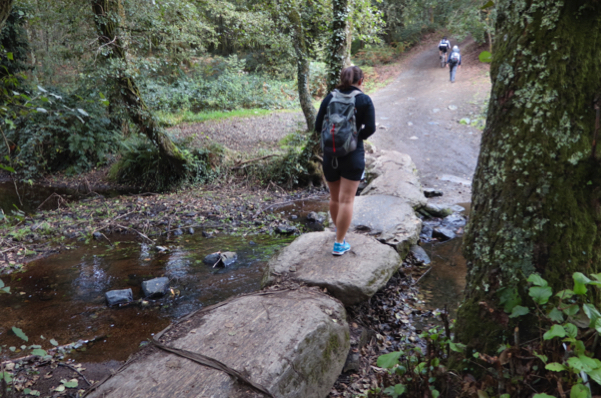
Rachel crosses a stone bridge along the Camino. The 500-mile trail boasts of a variety of landscapes—including mountains, rivers, eucalyptus forests, cow pastures and lush meadows.
“Why do you think God is reminding you of that?”
I thought of something she had said earlier. God has already marked out our paths, like the well-marked Camino. And then I connected some dots. Could walking show us our responsibility to abide in Him, one step at a time?
“Well, the passage also says that Jesus endured the cross with joy, and He perfects my faith,” I said. “So, He provides the grace we need to keep going.”
She nodded and smiled. “Did you ever think you’d be able to do this?” she asked. “Four years ago, you could barely exercise because of metal poisoning. Now you’re walking 75 miles of the Camino in six days.”
After my first day of walking, I laid in bed at a guesthouse, physically exhausted but mentally awake.
That day, I passed stone kilometer markers with scallop shell symbols and yellow arrows directing pilgrims. Rocks sat piled carefully on top of one another, representing the burdens pilgrims wanted to lay down.
What burdens am I carrying? I thought that night.
With God’s prompting, I decided to carry rocks for my family—one for my dad, one for my mom, one for my brother. Immediately I wept.
My dad’s illness, multiple system atrophy, has touched my family for the past three years. His body is deteriorating, yet he radiates God’s unfathomable peace. Serving as a full-time caregiver can weigh on my mom, and yet her joy and patience demonstrate God’s grace to anyone my parents interact with.
God has given my family this burden to carry. I knew God didn’t want me to toss this burden aside but to hold it and entrust it to Him.
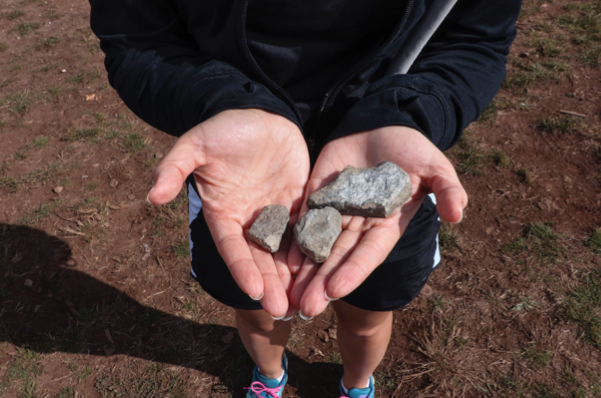
Rachel carries three rocks for her family—one for her dad, one for her mom, and one for her brother. Many pilgrims walk with rocks representing cares that affect them.
The morning of my final walking day, I picked up three rocks. I felt their edges as I gripped them. As the day wore on, I sometimes forgot I carried the stones. Other times, an edge poked me, reminding me to pray.
Arriving at the Camino’s final destination, the Santiago de Compostela Cathedral, I carried the rocks to the steps and placed them down one by one. This released familiar tears.
I can entrust my burdens to God.
I often equate rest with inactivity. But walking the Camino proved otherwise.
I had decided in advance what the Camino would be for me: I wanted to think deeply about life and about God. But several hours into walking, my mind grew tired of self-imposed pressure to have epiphanies.
The words of Matthew 11:28-29 quieted me: “Come to me, all you who labor and are heavy laden, and I will give you rest. Take my yoke upon you, and learn from me, for I am gentle and lowly in heart, and you will find rest for your souls.”
And you will find rest for your souls.
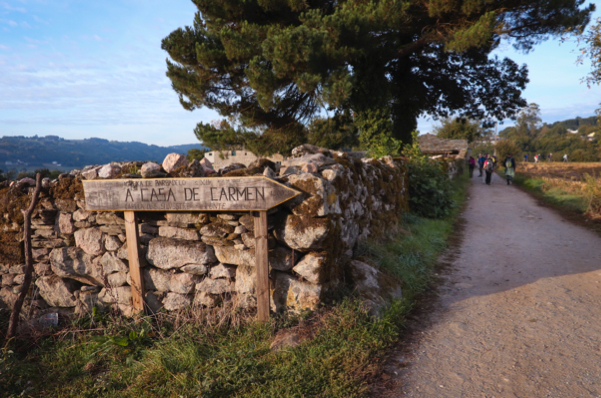
On the backdrop of an old stone wall, Casa de Carmen advertises a place of rest for pilgrims along the Camino. Hostels and guesthouses like this one often provide inexpensive beds and meals.
God used physical walking to release the pressure of my anxious mind. Where I wanted to constantly think, God enabled me to be present in the green, foggy meadows and tall forests. Though my feet ached with calluses, my soul found rest.
By the end of the Camino, God had bound physical walking and spiritual walking together.
The path wasn’t glamorous or even full of enlightenment. But I learned that the simple act of walking allows me to experience God in ways ancient believers once did.
Experience the Camino or other similar trips with Cru.

Rachel, a Pittsburgh native, serves as director of content strategy and as a story editor for digital and print communications for Cru®. A 2012 graduate of Ohio University, she received a journalism degree, which so far has taken her around the U.S., to Morocco, Russia, Spain and Moldova.
Contact Me